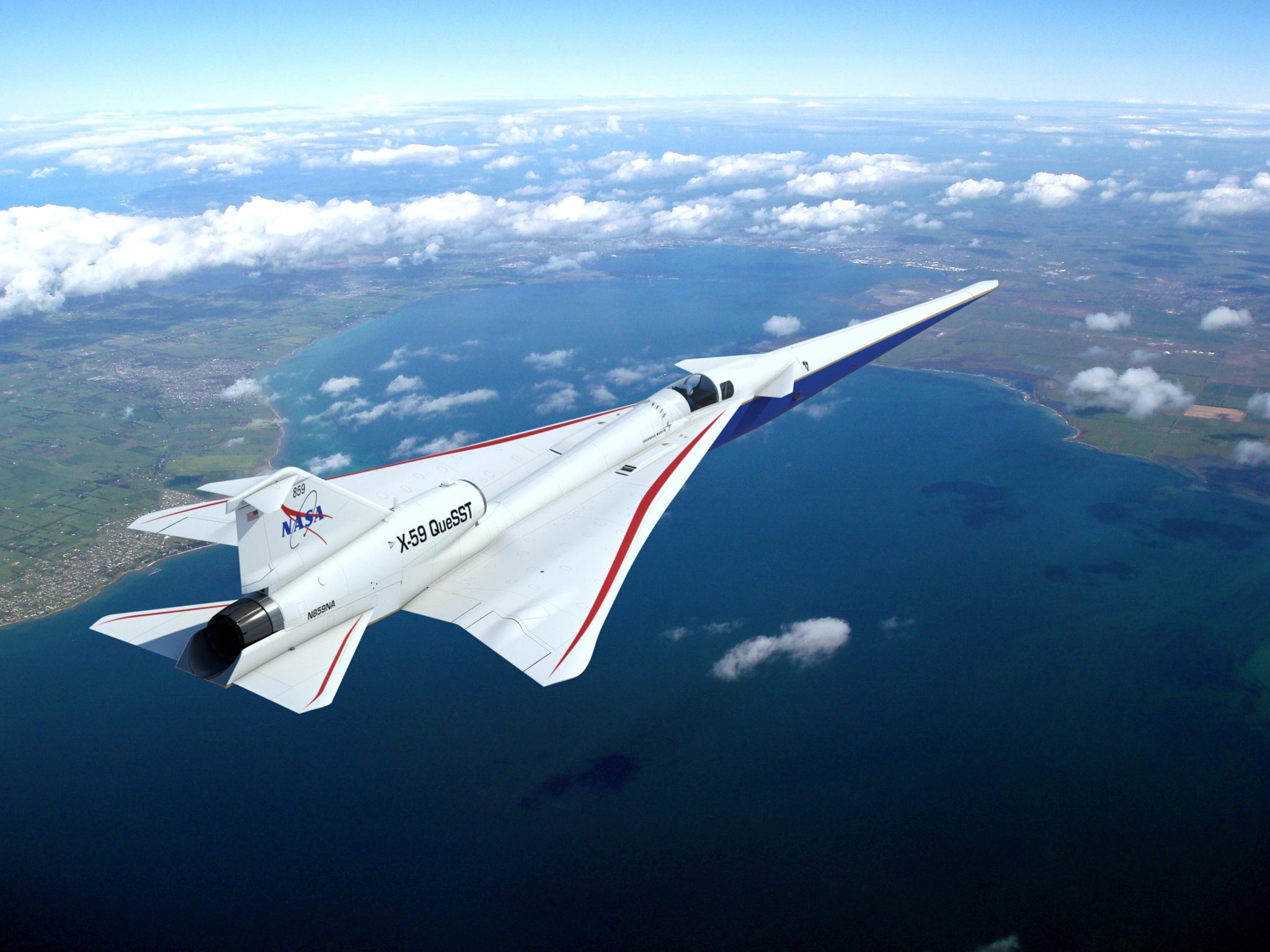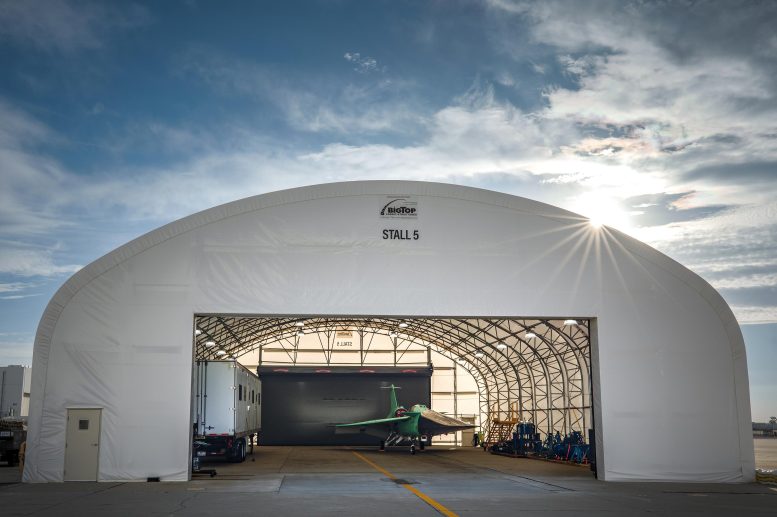
Posted on 07/11/2023 1:26:40 PM PDT by Red Badger

NASA’s X-59 QueSST
This artist’s concept of NASA’s QueSST jet reflects the airplane’s final configuration following years of research and design engineering. The jet is now under construction by Lockheed Martin at the company’s Skunk Works facility in Palmdale, California. Credit: Lockheed Martin
NASA’s X-59 aircraft, capable of supersonic flight while reducing sonic booms to quieter ‘thumps’, has been moved for testing in California. The collected data on human reactions to supersonic noise will potentially assist in enabling commercial supersonic flight over land.
The following series of images shows NASA’s X-59 as it sits on the flight line—the space between the hangar and the runway—at Lockheed Martin Skunk Works in Palmdale, California, on June 19, 2023. The move from its construction site to the flight line is one of many milestones that prepare the X-59 for its first and subsequent flights. Next up, the team will conduct significant ground tests to ensure the aircraft is safe to fly.

NASA X-59 Aircraft Near Runway at Lockheed Martin Skunk Works
Technicians check out the X-59 aircraft as it sits near the runway at Lockheed Martin Skunk Works in Palmdale, California, on June 19, 2023. Credit: Lockheed Martin
The X-59 aircraft—the centerpiece of NASA’s Quesst mission—is designed to demonstrate the ability to fly supersonic, or faster than Mach 1, while reducing the loud sonic boom to a quiet sonic thump. NASA will then fly the X-59 over several communities to gather data on human responses to the sound generated during supersonic flight. NASA will deliver that data set to U.S. and international regulators to possibly enable commercial supersonic flight over land.

NASA X-59 Aircraft Runway at Lockheed Martin Skunk Works
NASA’s X-59 aircraft is parked near the runway at Lockheed Martin Skunk Works in Palmdale, California, on June 19, 2023. This is where the X-59 will be housed during ground and initial flight tests. Credit: Lockheed Martin
The Quiet Supersonic Technology (QueSST) mission, spearheaded by NASA’s aeronautical innovators, is a pioneering collaboration between government and industry aimed at making overland supersonic flight a reality. This revolutionary step could drastically cut travel times across the United States and globally.

NASA X-59 Aircraft Parked Near Runway at Lockheed Martin Skunk Works
NASA’s X-59 aircraft is parked near the runway at Lockheed Martin Skunk Works in Palmdale, California, on June 19, 2023. This is where the X-59 will be housed during ground and initial flight tests. Credit: Lockheed Martin
The QueSST mission has two main objectives. Firstly, to design and construct the X-59 research aircraft, equipped with cutting-edge technology that mitigates the deafening sonic boom typically associated with supersonic travel to a gentle thump perceptible to those on the ground. The second objective is to fly the X-59 over various communities across the U.S., collecting vital data on how humans respond to the noise generated during supersonic flight. This collected data will then be shared with U.S. and international regulators.
The aim is to utilize this information to write and implement new sound-based regulations surrounding supersonic flight over land. This could potentially unlock new commercial cargo and passenger markets, offering the tantalizing possibility of faster-than-sound air travel.
Yeah, stupid me to write that. The huge benefit will be carrying John Kerry to climate conferences on the other side of the globe in half the time. Ten times every year.
That thing’s gonna poke somebody’s eye out if they’re not careful.
Forward viz looks a bit restricted.
I fly Hawaii to Arizona and back several times a year, and the flights in coach sucks.
But I cannot justify paying for 1st class, and likely not for any upcoming SST either.
So I writhe for 6+ hours
Canard, wing, and two sets of stabilizers on the tail. And a fuselage design that looks like it’s modified from a Constellation.
Hmm ..... maybe not a good idea to name the aircraft hanger “Stall”? 8-)
Australia ... several times.
The discomfort varies greatly with the aircraft type. I really don't fit well in 787 seats. A380 was much less uncomfortable. 777 is not bad, either.
Will be more interested when they show the potential armaments it can carry next to it...
Because they can.......................
Looks like a forgotten Century Series concept.

If you can fly at 3000+ mph, then you need only ONE....................
Interesting return to the past... I have fond memories of several times having ATC tell me “You are number two for 36 Left following the Concord. Avoid wake turbulence! A memorable sight to this date!
Hmmm...
Does that mean that you take off somewhere in the central U.S, get up to speed before you hit the west coast, and drop the bomb as soon as you reach Hawaii?
Do Newton's laws still hold or will we be referencing Minkowski diagrams to make the determination?
Snicker...
cool
Why Mach 1.6 limit? I cite the following:
1. It means less thermal heating of the structure of the plane, so more composite materials can be used to keep the weight lower.
2. A Mach 1.6 limit means any sonic boom with such an advanced design will be very low indeed.
3. The plane don't need to run the engine with fuel-consuming reheat (neé afterburner) mode or very little use, which means higher fuel efficiency at supersonic speeds.
Both FlexJet and NetJets are very likely interested in such a plane. Both could order 40 planes for fractional ownership operations.
Disclaimer: Opinions posted on Free Republic are those of the individual posters and do not necessarily represent the opinion of Free Republic or its management. All materials posted herein are protected by copyright law and the exemption for fair use of copyrighted works.